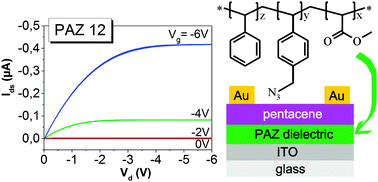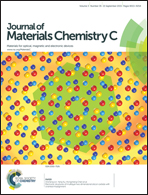Cross-linkable random copolymers as dielectrics for low-voltage organic field-effect transistors
Abstract
A large number of cross-linkable dielectrics with good dielectric properties have been reported; however, all of them suffer from disadvantages like uncontrolled pre-crosslinking, necessity of high process temperatures and the need for an additional cross-linking compound. In this contribution, two new poly(methyl methacrylate) polymers are introduced which can be cross-linked due to the attached benzyl azide (N3) monomer units making the addition of hardeners or initiators obsolete. The synthesis of the copolymers as well as their successful characterization and usage as gate dielectrics for organic field-effect transistors is demonstrated. The investigated polymers have been labeled PAZ 12 and PAZ 14 according to their azide content in mol%. The additional building blocks of the polymers are methyl methacrylate for PAZ 12 and methyl methacrylate and styrene monomer units in about an equal ratio for PAZ 14. Spin-coated thin films were cross-linked by a thermal treatment at 110 °C followed by an UV exposure at a wavelength of 254 nm yielding insoluble, smooth and electrically dense polymeric networks. Optimal cross-linking parameters were obtained using infrared spectroscopy to follow the N3 vibrational mode. Its disappearance confirms a complete cross-linking reaction, and thus fully reacted azide groups facilitate the analytics. The dielectric properties of the cross-linked thin films have been studied by impedance spectroscopy. The application of double layer dielectrics results in lower dielectric losses and lower leakage currents in the subsequently produced pentacene-based field-effect transistors. These devices operate at voltages below −6 V and show hysteresis-free current–voltage characteristics with hole mobilities up to 0.16 cm2 V−1 s−1. PAZ 12 appears to be superior to PAZ 14 due to a lower total layer thickness of down to 92 nm still providing good insulation in the transistor presumably related to a lower free volume that arises in the cross-linked network of the two-component containing copolymer PAZ 12.


 Please wait while we load your content...
Please wait while we load your content...